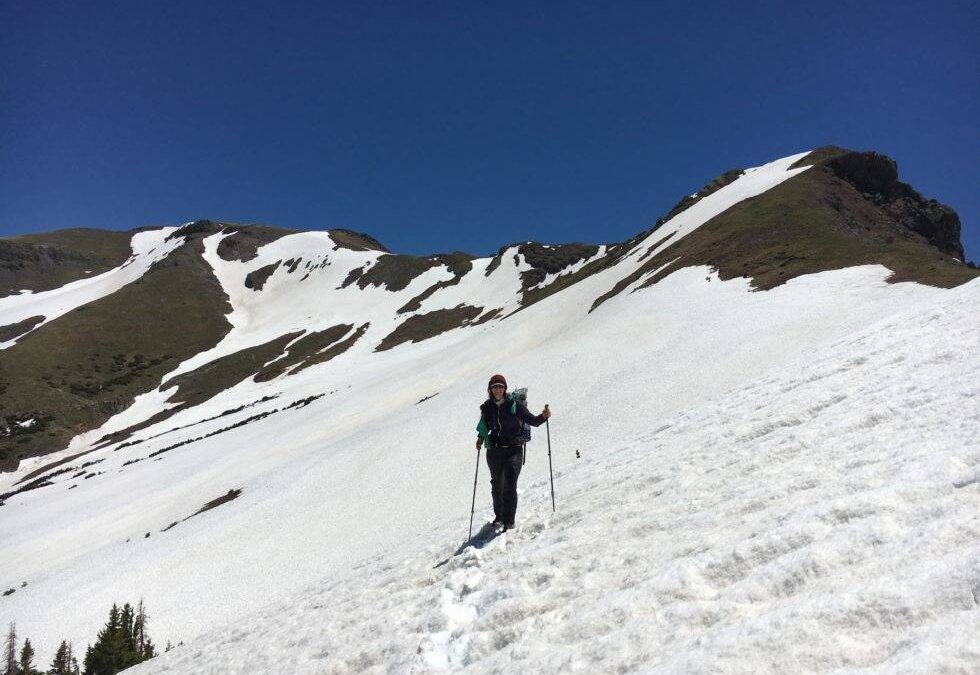When you’re getting dressed to go for an adventure in the colder months, layering is your best friend. Proper layering can allow you to easily regulate your temperature and avoid overheating or getting too cold. Check out our tips for how to layer while getting out on the CDT in the winter months.
By Callie Smith (Photo by Matt Berger from the San Juan/Rio Grande National Forest. Núu-agha-tʉvʉ-pʉ̱ (Ute)/ Pueblos Native Lands)
Top:
On the top, you will first need to start with a base layer – this will be the piece of clothing that directly touches your skin. Base layers should be made of a warm and moisture wicking fabric such as wool or polyester (cotton is not recommended for this because it does not dry quickly enough and can leave you very chilly if it gets wet or you sweat in it). Next, you will want a mid-layer which can be anything from a light fleece on a slightly warmer day, to a down jacket (also called a puffy) in really cold weather. If it is a particularly cold day, you can add two mid-layers, such as a fleece then a puffy, however, be sure not to overheat yourself and take off layers when appropriate to avoid sweating too much. Finally, you will want an outer layer. An outer layer is meant to protect you from elements such as wind and rain so you will want something waterproof such as a rain jacket for this.
Bottom:
On the bottom, you will also want to start with a base layer that is warm and moisture wicking. Some people don’t use mid layers on the bottom, however, if it is a particularly cold day you can opt for something like fleece pants over your base layer. Finally, depending on the weather and overall temperature, you may want to wear something waterproof on the bottom as well. Rain pants are great at keeping moisture off and provide a fairly good amount of warmth. If it is particularly cold, something with more insulation such as ski pants will definitely keep you warm.
Extremities:
Feet:
It is important to have good quality socks when adventuring outside in the cold. Wool socks are a great option for this as they dry quickly and keep you very warm. Additionally, some people choose to wear lightweight sock liners underneath their wool socks for added warmth and blister prevention. Hiking boots or snow boots that are waterproof and have good insulation are the best option for winter weather activities.
Darn Tough makes Merino wool socks that keep your feet warm in cold, wet conditions and partners with CDTC to complete, promote, and protect the trail. Darn Tough donates 5% of proceeds from each pair of their CDT Micro Crew Lightweight Hiking Socks to support CDTC’s work, so you can stay warm while you’re winter hiking, and give back to the trail.
Hands:
Having warm hands can drastically improve your happiness when out and about in the cold. Gloves and mittens are essential to keeping your hands warm. For a warmer day, a good pair of gloves will do the trick. When picking out gloves, opt for something that will dry quickly, or, even better, is waterproof. For colder weather, heavier gloves can work but mittens tend to keep your hands the warmest and wearing liners inside your mittens will add an extra layer of comfort.
Head:
It is extremely important to keep your noggin warm while out on the trail! A good quality hat along with a balaclava or buff will make sure your face and head aren’t exposed to the elements.
The most important thing to remember with layering for the cold weather is to continually check in with yourself and your body. Layering systems should always be versatile and adjustable for weather and body temperature changes. Having multiple layers will give you options to regulate your own body temperature for a variety of different weather conditions and activity levels. If you are beginning to sweat, take off a layer. Taking a break from hiking or snowshoeing to eat lunch? Add a layer or two so you don’t get cold. Doing this can ensure you will have a good time and be safe while out on the trail!
Callie Smith is the Community Engagement Coordinator at the CDTC. In her free time she enjoys whitewater rafting and cooking.

